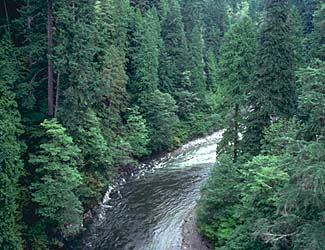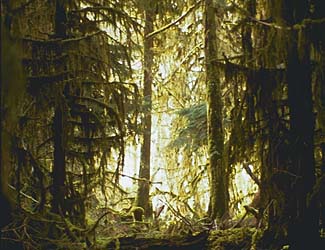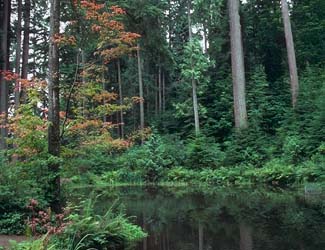GAP Analysis Predicted Distribution Map
Pacific Giant Salamander (Dicamptodon tenebrosus)
Species Code: DITE
|
Legend:
 = Core Habitat = Core Habitat
 = Marginal Habitat = Marginal Habitat
Metadata
(Data about data or how the map was made)
Predicted Distribution
Amphibians do not migrate as some birds and mammals, so the colored areas depict the predicted range for the Pacific Giant Salamander year-round. The habitats were identified using 1991 satellite imagery, other datasets and experts throughout the state, as part of the Washington Gap Analysis Project.
Click to enlarge distribution map
|
Distribution and Habitat Requirements
This salamander is largley retricted to moist conifer forests and along streams during breeding (Nussbaum et al., 1983). It
is found along and somewhat east, but mostly west, of the Cascades crest, except on the Olympic Peninsula. This species
occurs on Fidalgo Island (Slater, 1941).
This species is associated with small streams. Although primarily a forest species, it has been found in streams with steep ravines
in low-density developed residential areas.
Models
The Cascades ecoregions, except the Northeast Cascades and the southern portions of the Olympic Peninsula were selected. All
lower elevation zones west of the Cascades including the Western Hemlock zone were core. The Silver Fir zone was core except
in the Northwest Cascades, where is was marginal. Western Hemlock and Interior Western Hemlock zones were core east of
the Cascades. Marginal zones included Mountain Hemlock south of Snoqualmie Pass and the
Grand Fir, Oak, Ponderosa Pine and Interior Douglas-fir zones east of the Cascades.
The dry woodlands in Thurston County and the Chehalis River Valley appear to act as a barrier to its entry into the
Olympic Peninsula.
Riparian areas were good habitats. All classes of open and closed hardwood/conifer and conifer forests, low-density developed
residential areas, including parks, and wooded forests surrounded by lightly developed residential areas, were considered
suitable if adequate microhabitats were available.
Translated from the Washington Gap Analysis Amphibians and Reptiles Volume by Karen Dvornich
Webpage designed by Dave Lester

 = Core Habitat
= Core Habitat = Marginal Habitat
= Marginal Habitat

